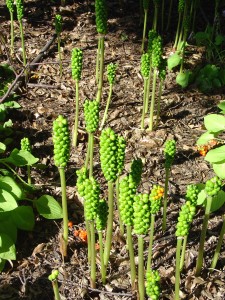Italian arum (Arum italicum) is a long-lived woodland perennial native to Italy and much of the Mediterranean region. Several members of the arum family (Araceae), including this species, are also known as “Lords and Ladies”. It typically grows 9-18 inches tall (depending on location) and slowly spreads over many years.
Shoots first emerge from beneath the woodland leaf litter in autumn. The brightly-veined foliage appears when most perennials are entering winter dormancy. Long-petioled, shiny green, arrowhead-shaped leaves are 8-12 inches long with distinctive white netted venation. Italian arums grow best in medium moist, organically rich soils in part shade to full shade. Hardy in USDA zones 6 to 9, it also prospers in protected areas in zone 5.
In spring greenish to creamy yellow flowers (called “spathes”) emerge; they’re similar to flowers of jack-in-the-pulpit (Arisaema spp.). In summer stems, spadix portion of the flower is laden with green berries which ripen orange-red. Soon afterwards, it enters a dry summer dormancy period and completely disappears.
Italian arums form plant colonies and are long-lived. Leaves and the colorful berries are toxic and are deer and vole resistant. Plants are easy to dig up and divide in late winter. Mowing them down seems to make plants proliferate. Fertilizing clumps appear to be unnecessary if soil is humusy (from rotted leaves and debris) and soil moisture are plentiful.
Italian arum makes a perfect companion plant for shade loving summer perennials such as hostas, Solomon seals, astilbes, and ferns or winter add-ons with Lenten roses (hellebores). Italian arum is not susceptible to insect or disease problems and deer and voles stay away.


 Posted in
Posted in 
